
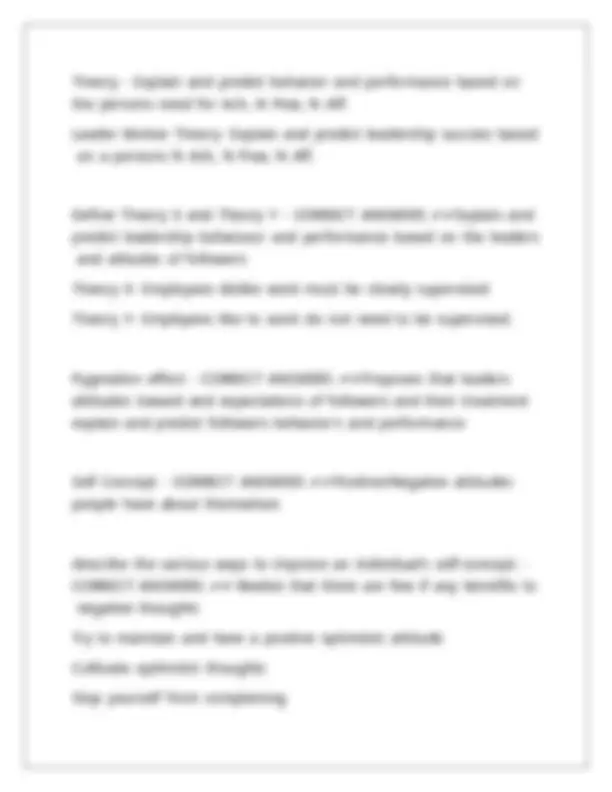
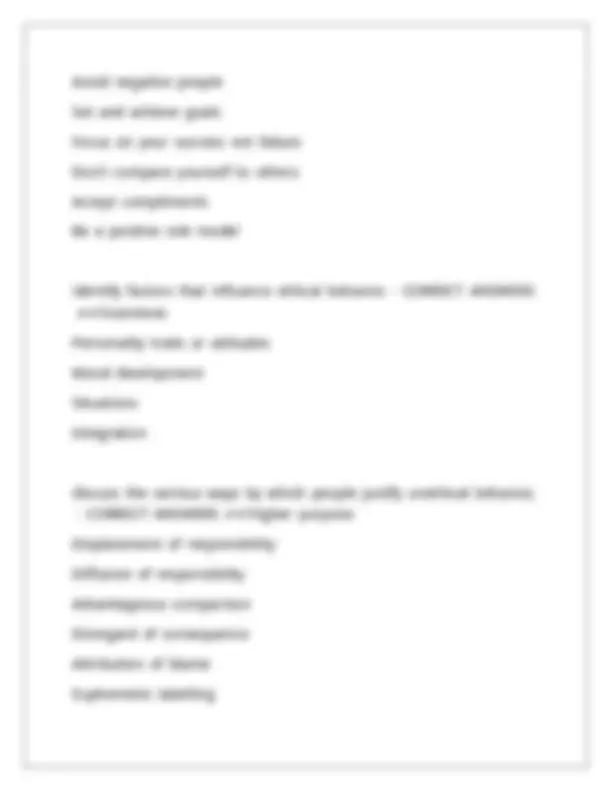
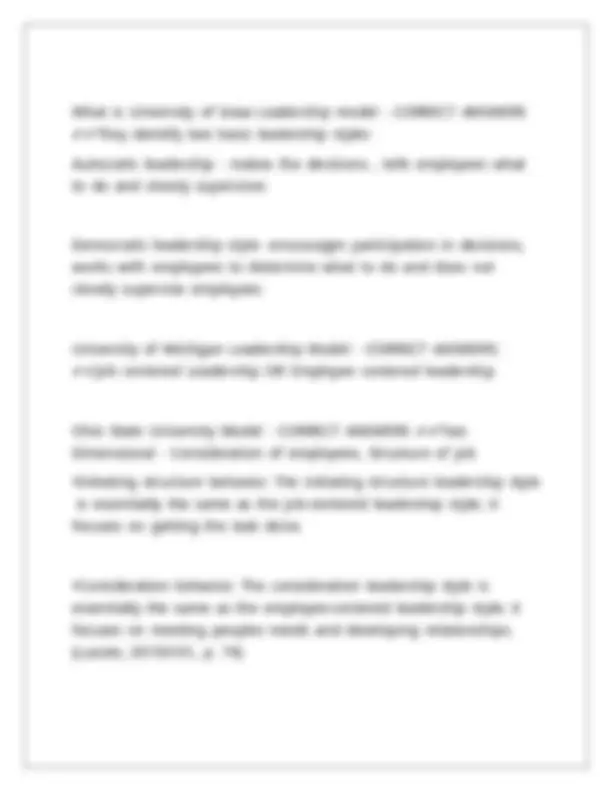
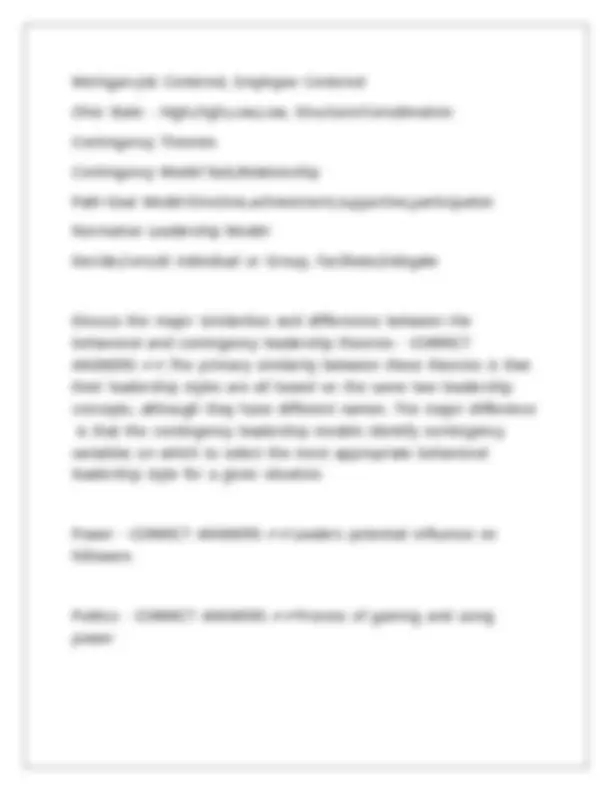
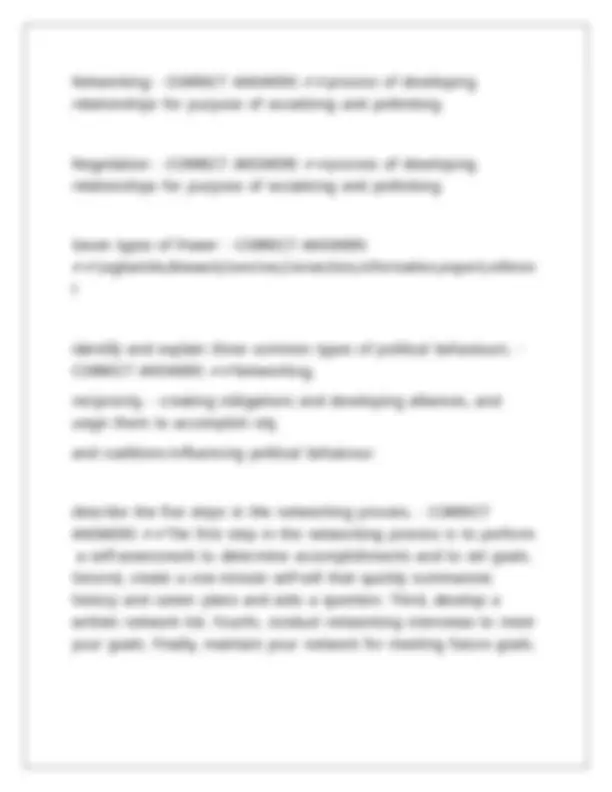
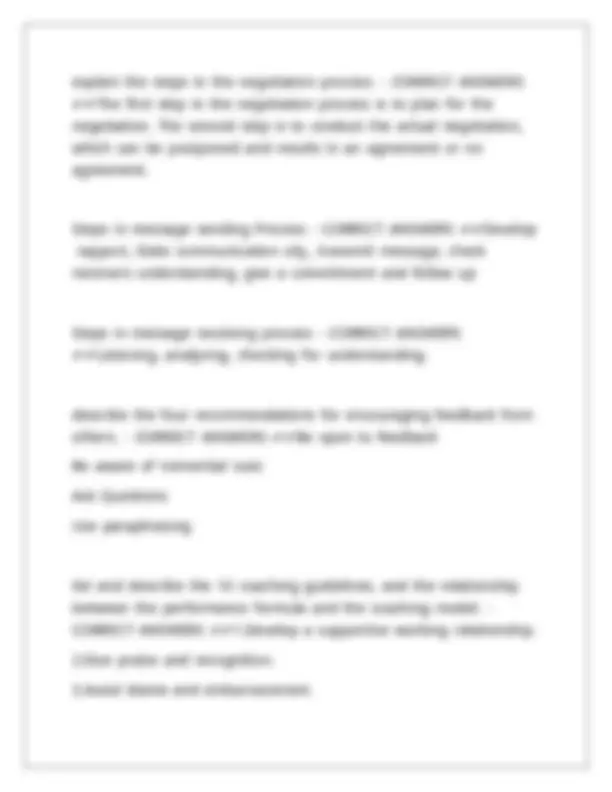
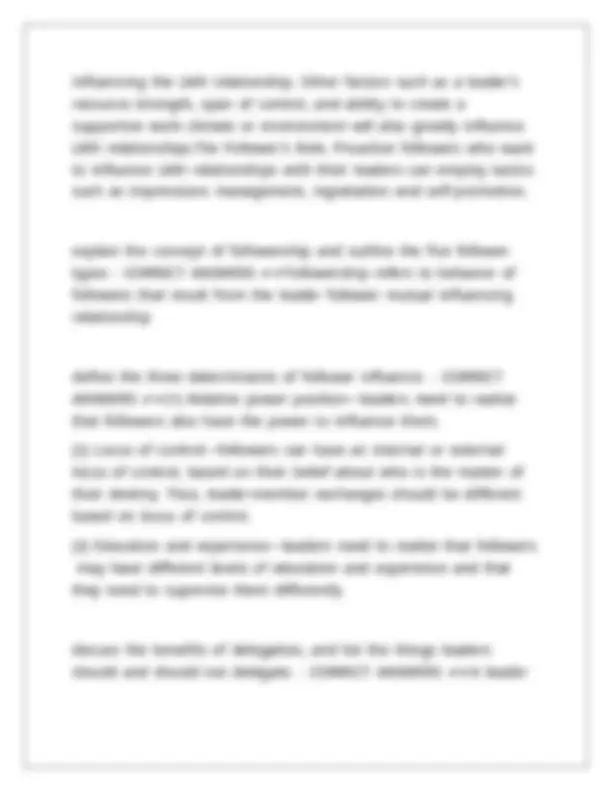
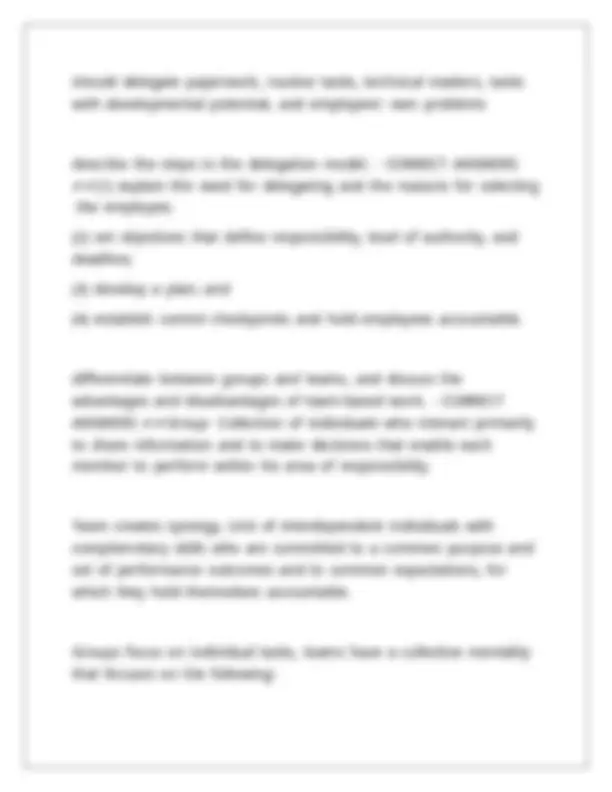
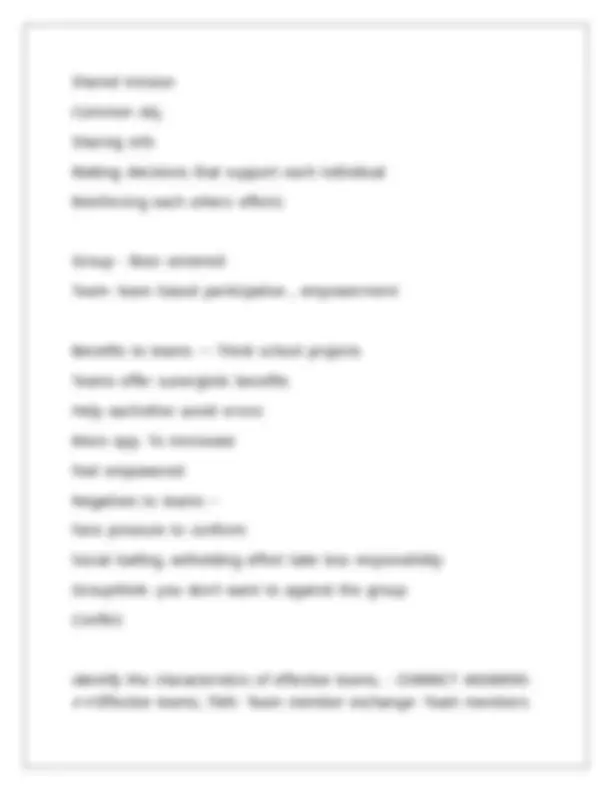
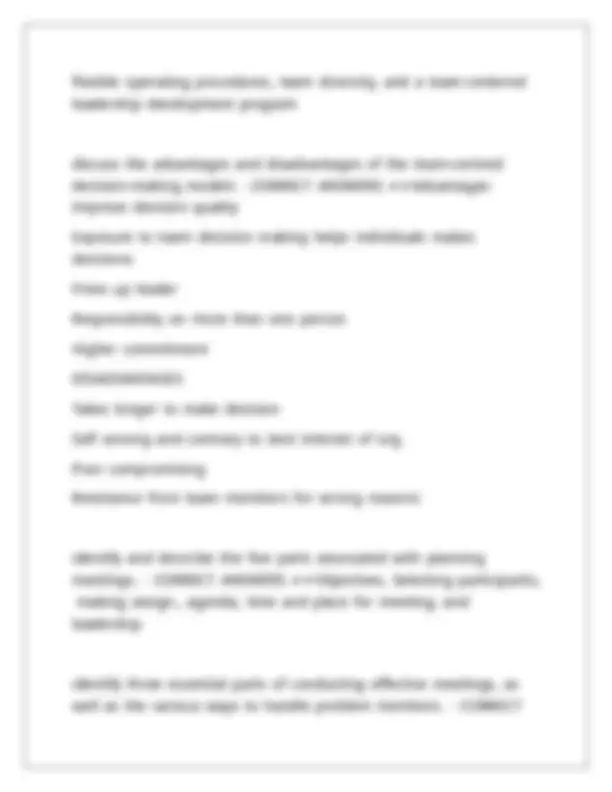
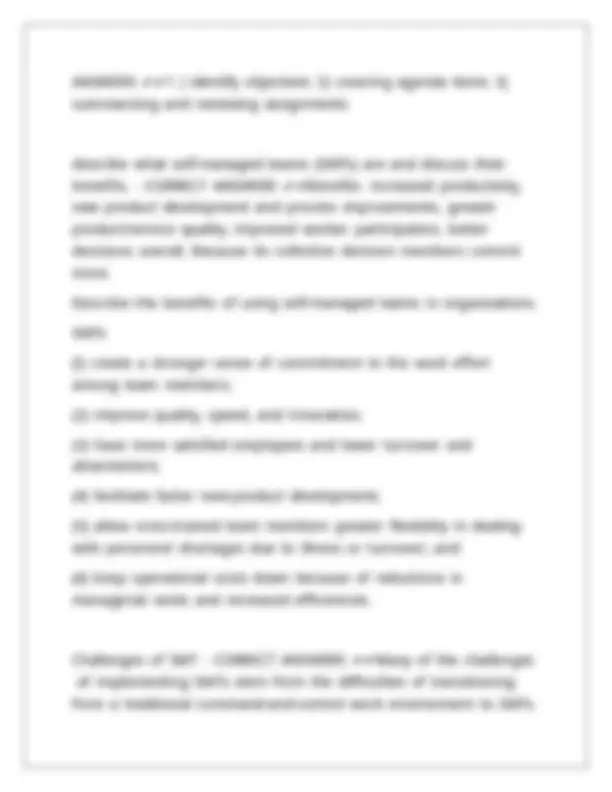
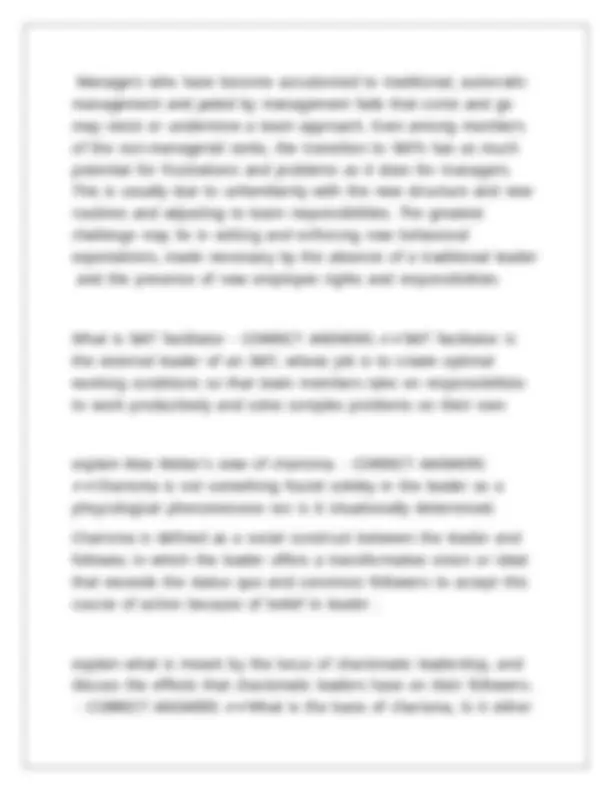
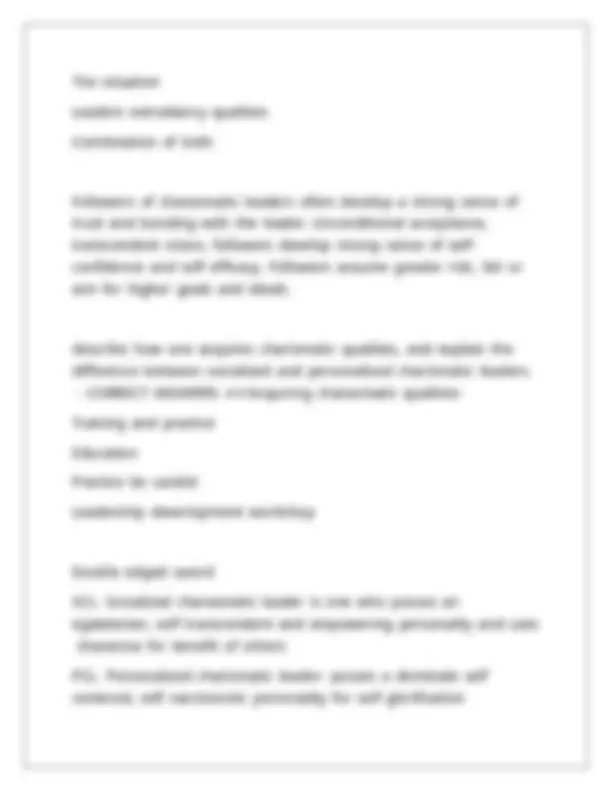
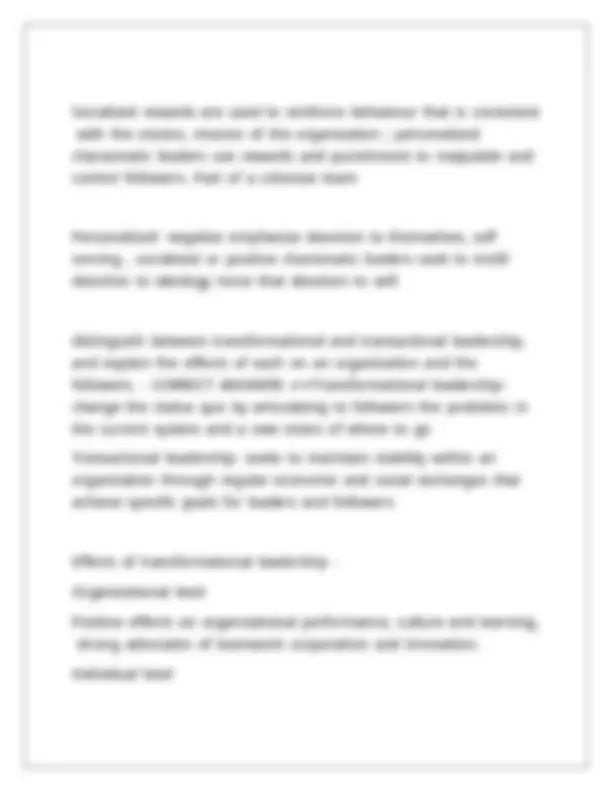
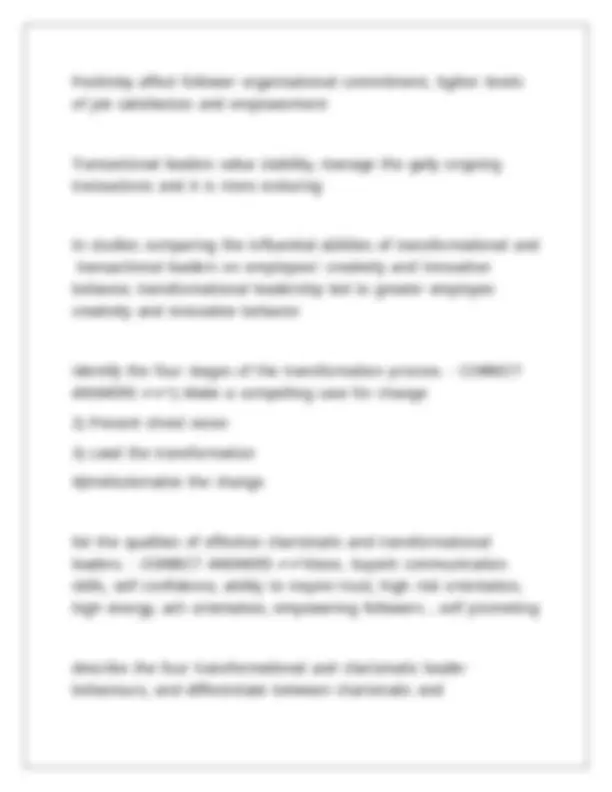
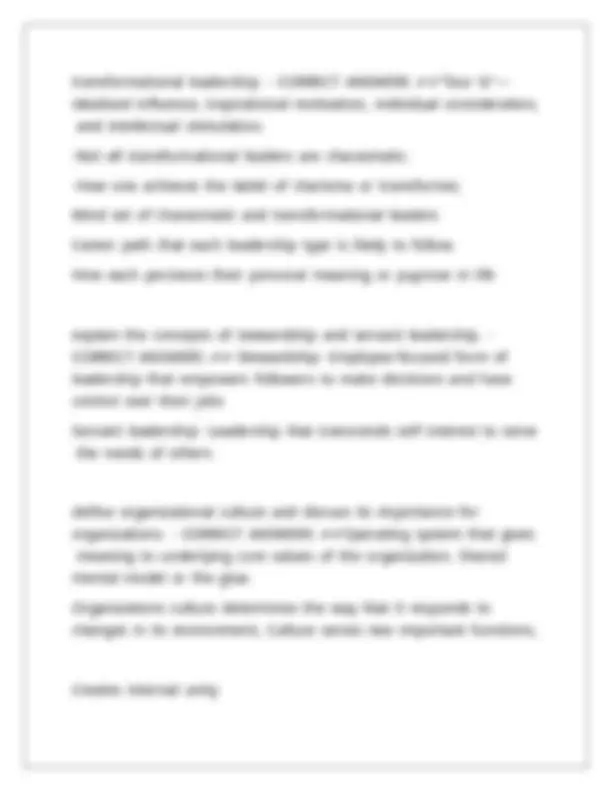
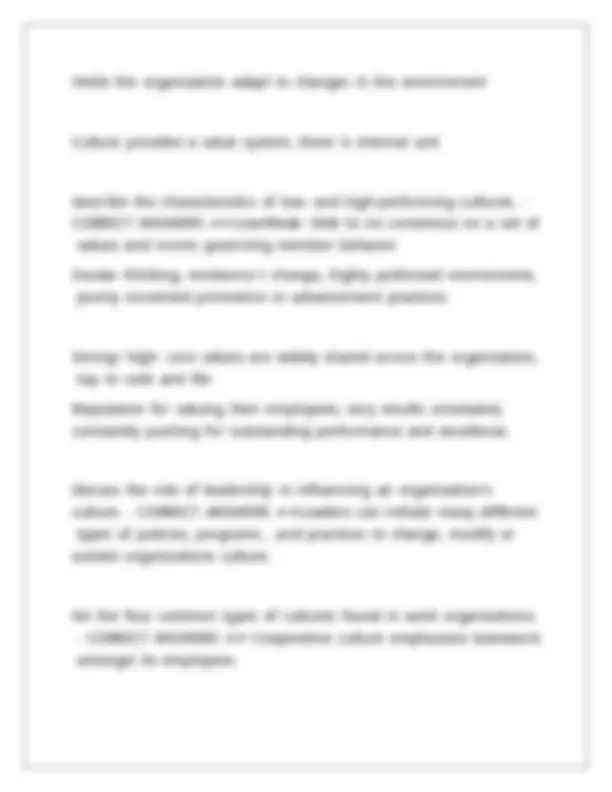
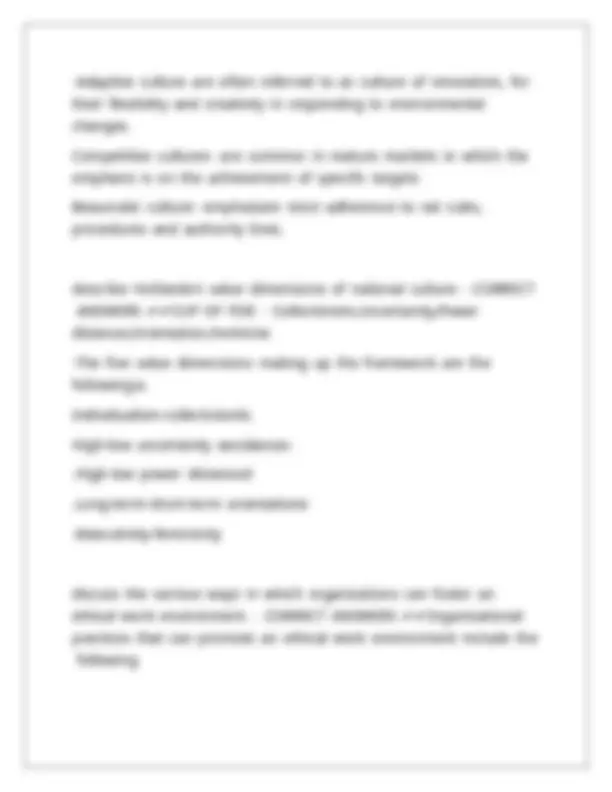
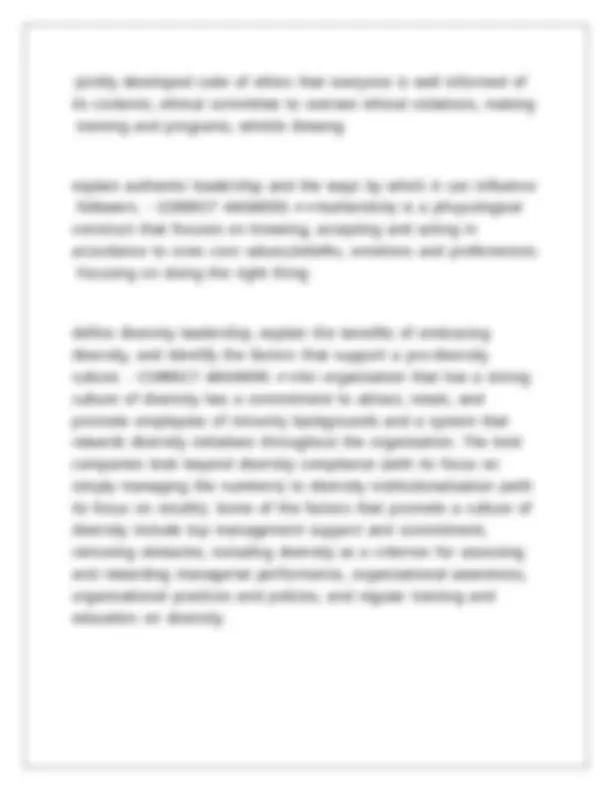
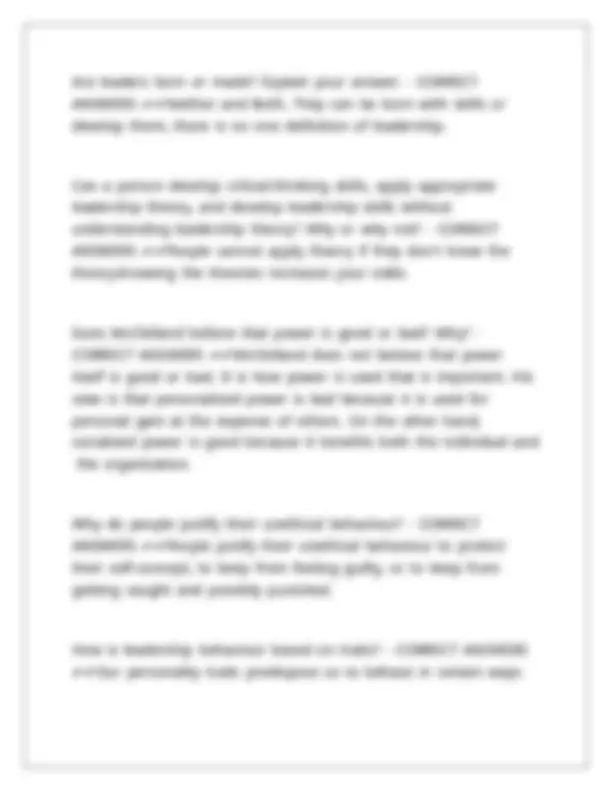
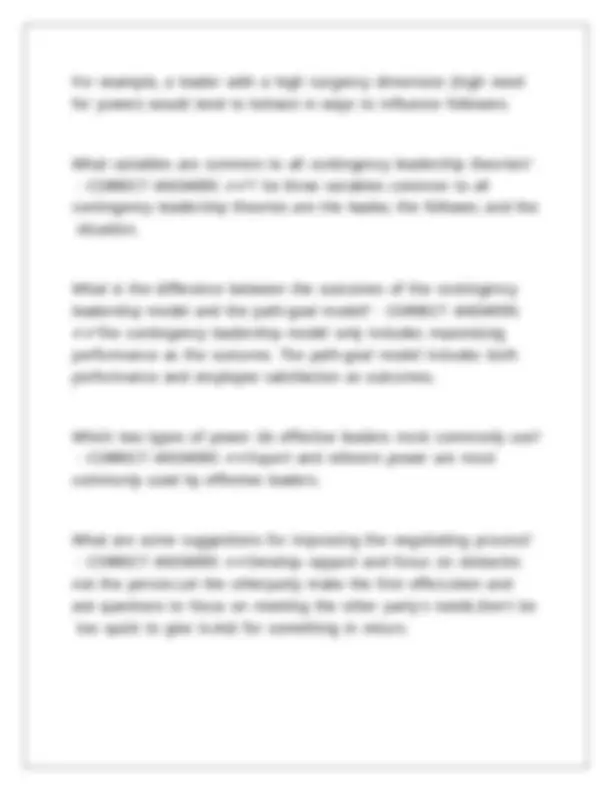
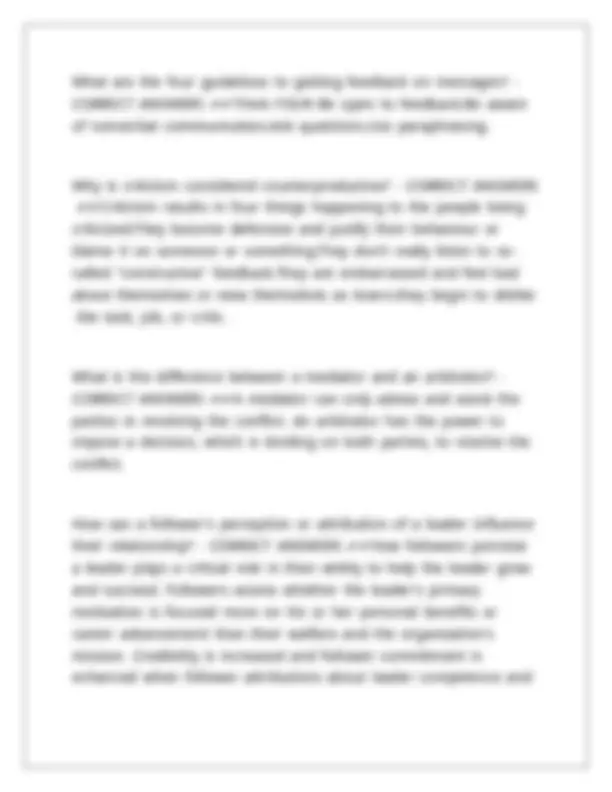
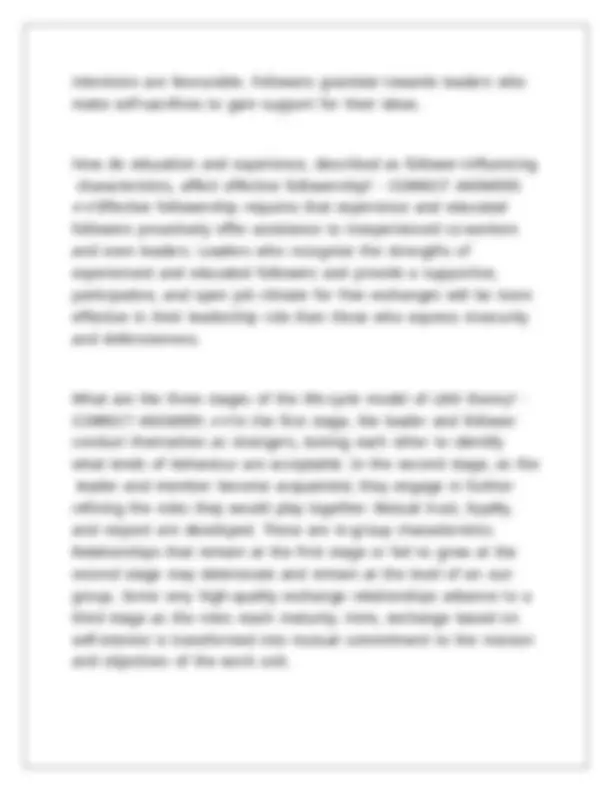
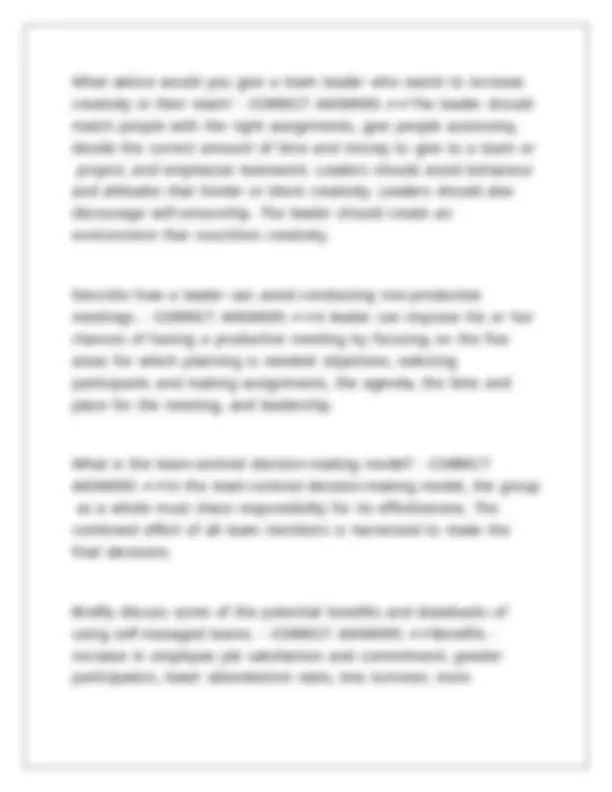

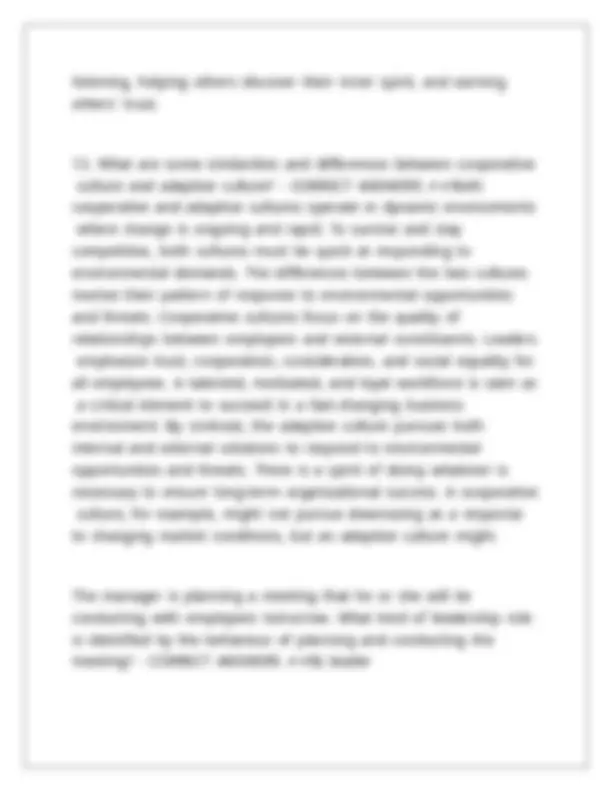
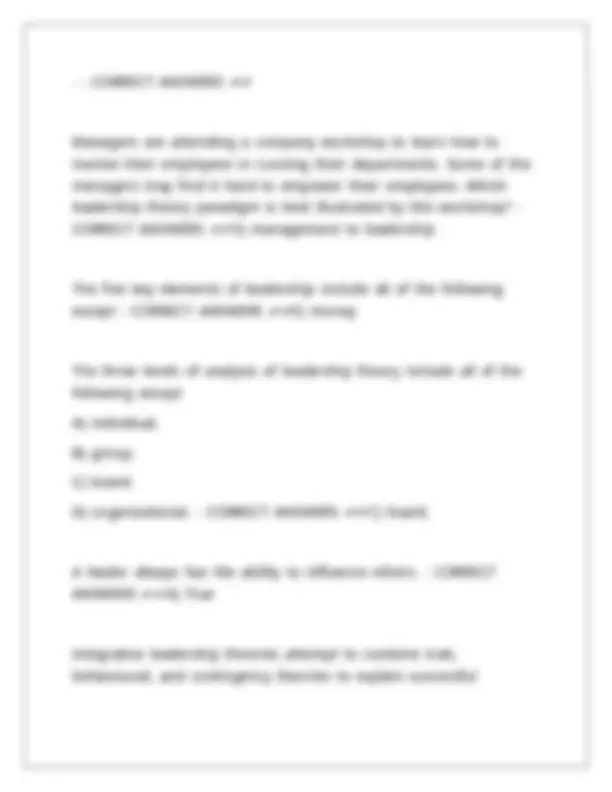
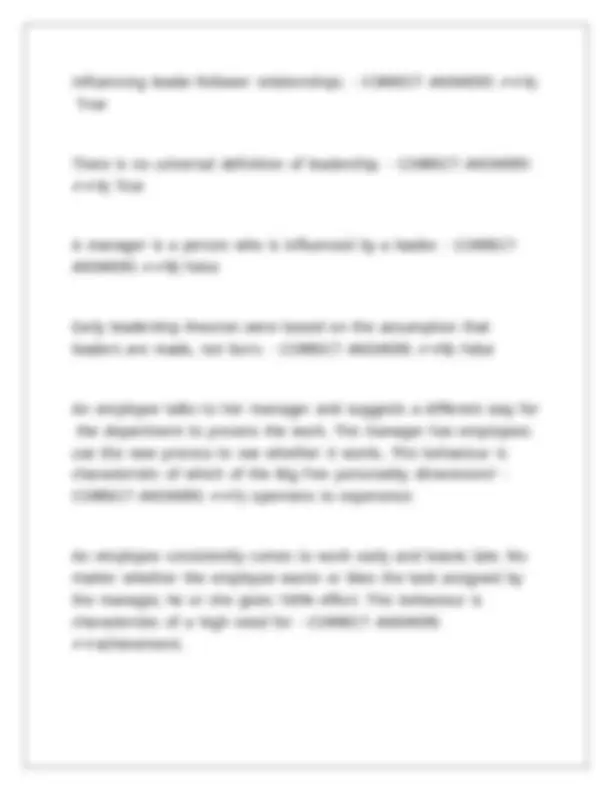
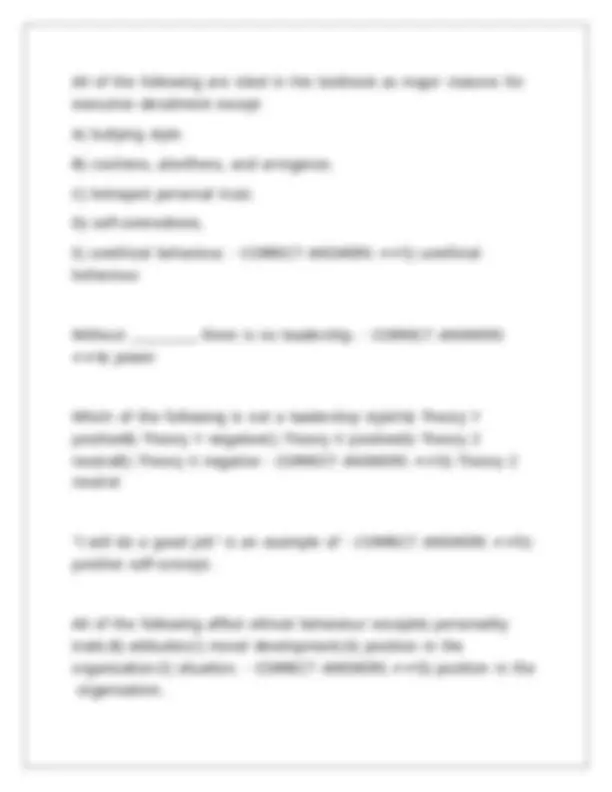
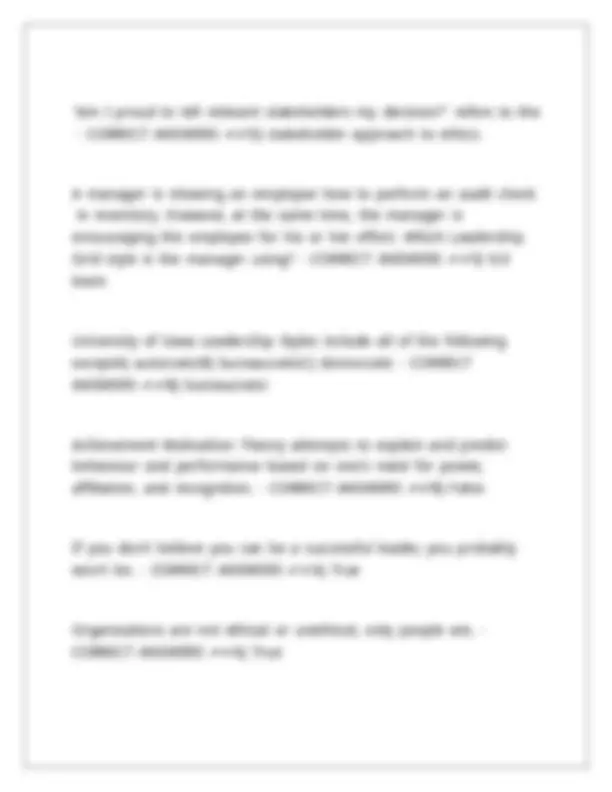
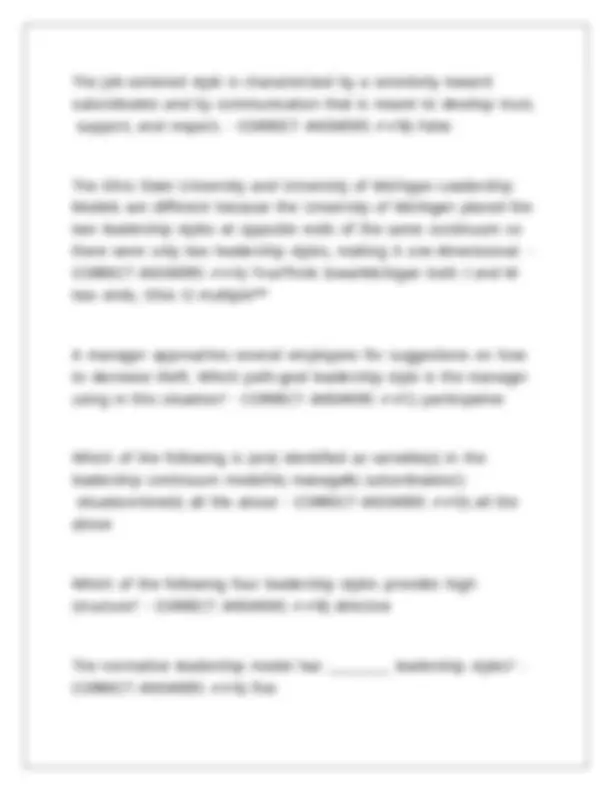
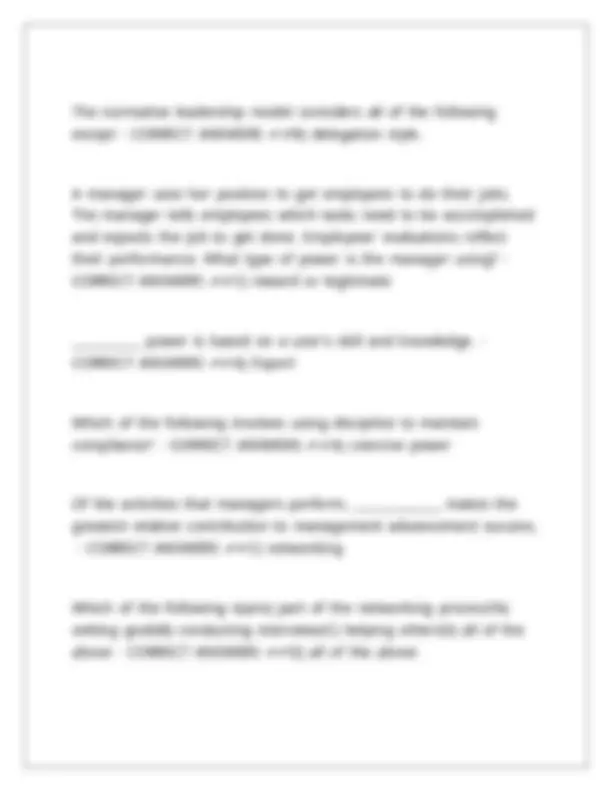
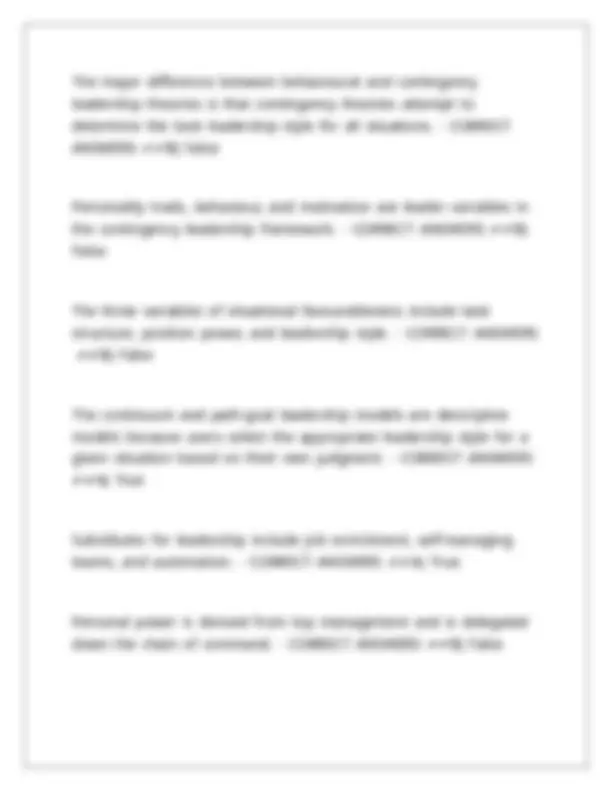
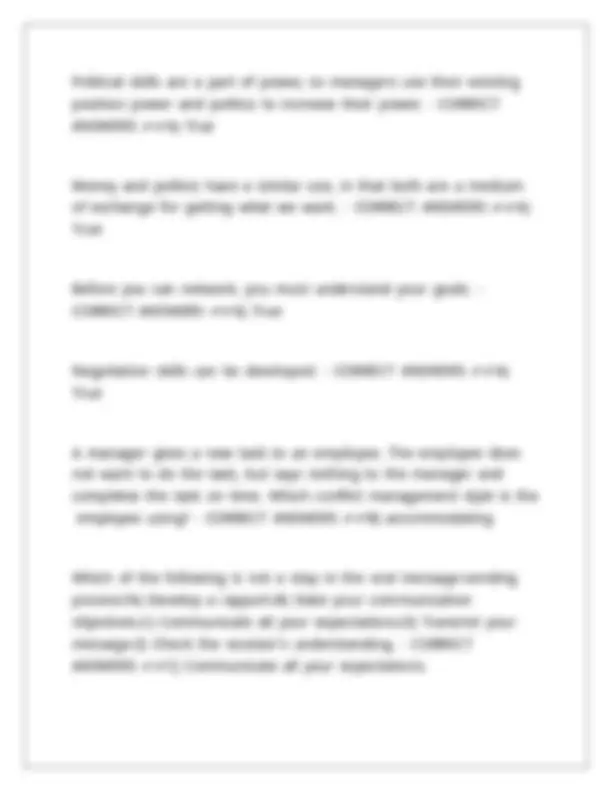
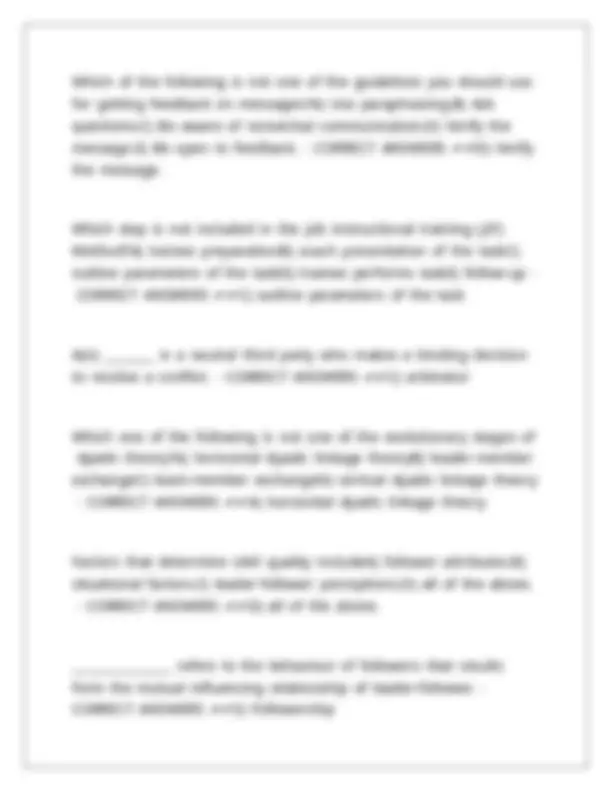
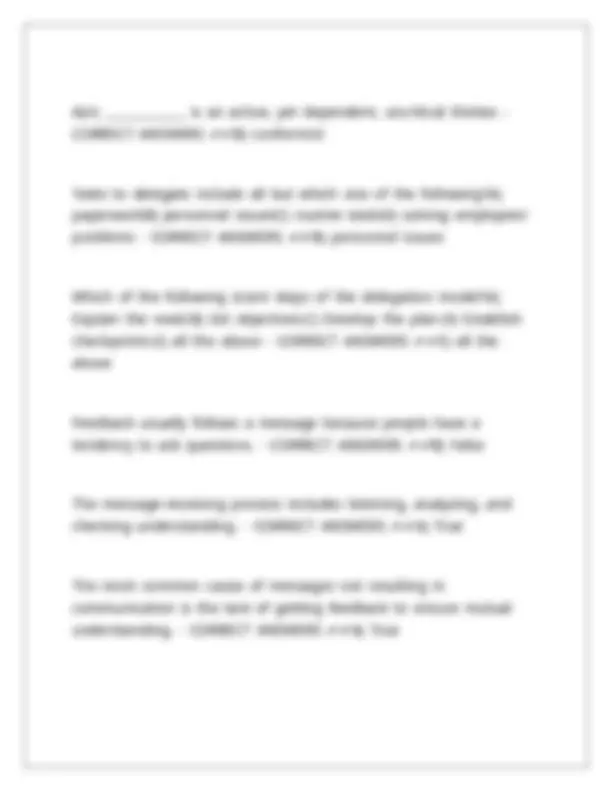
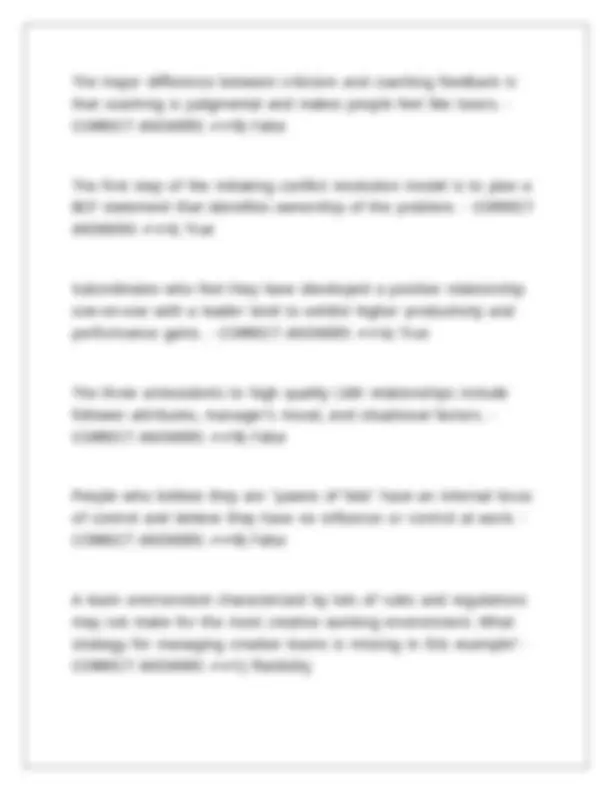
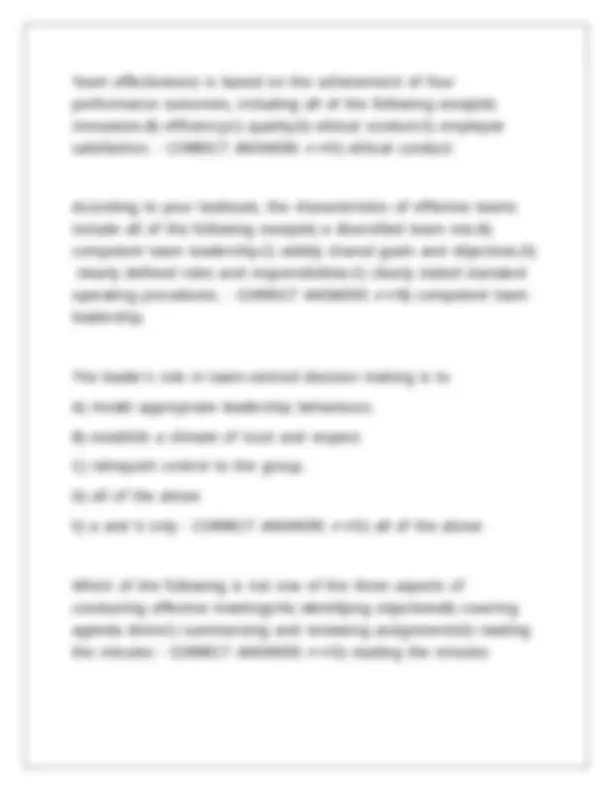
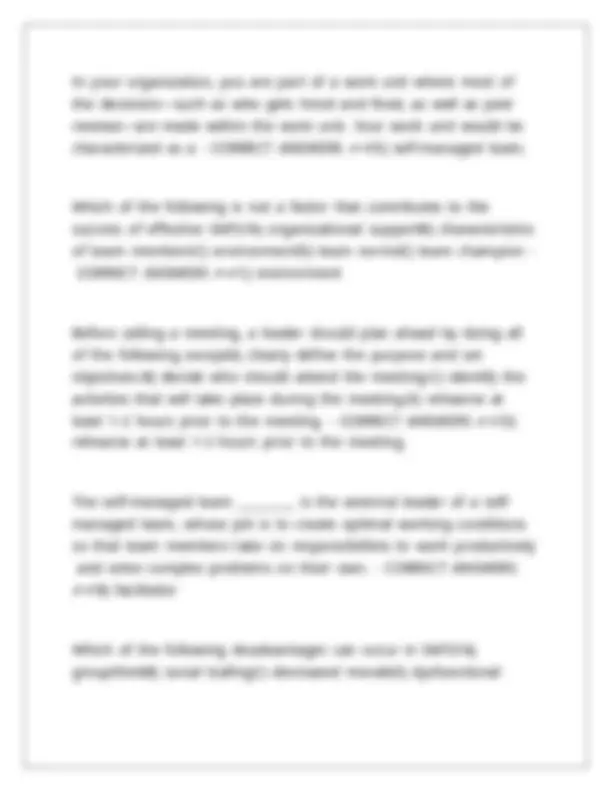
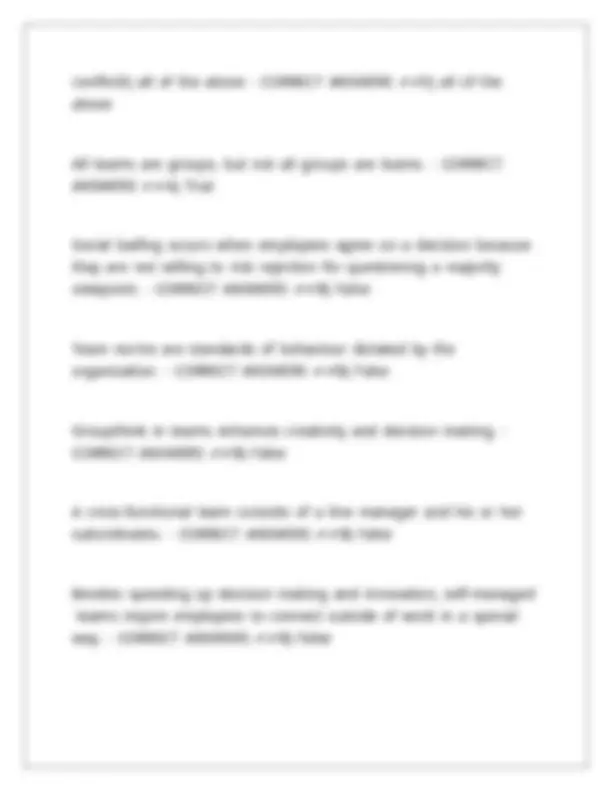
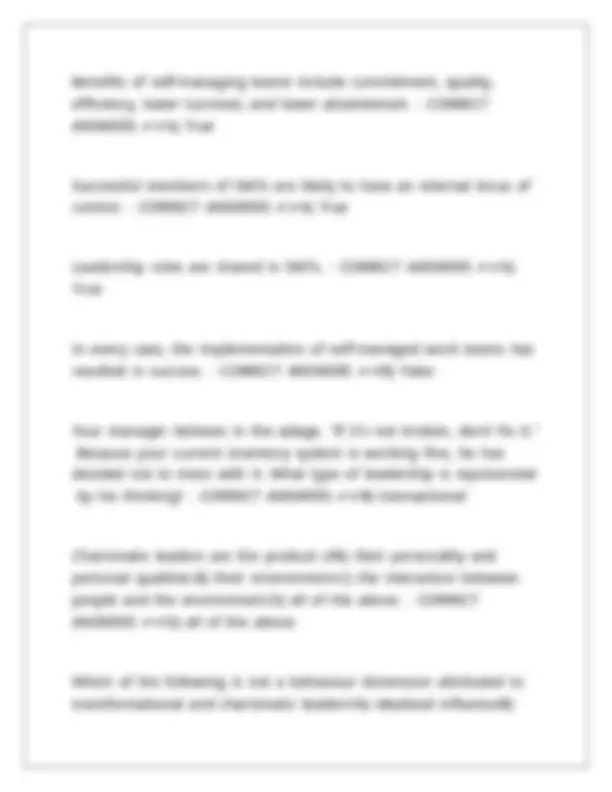
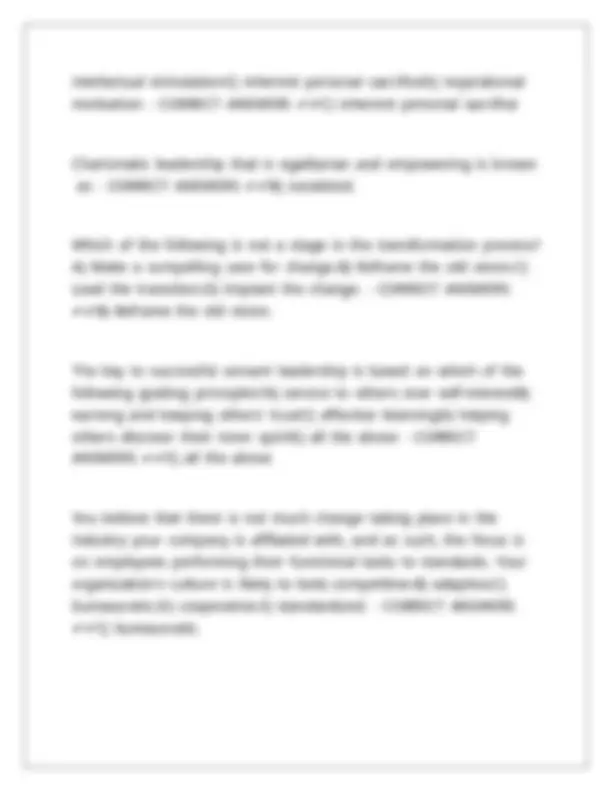
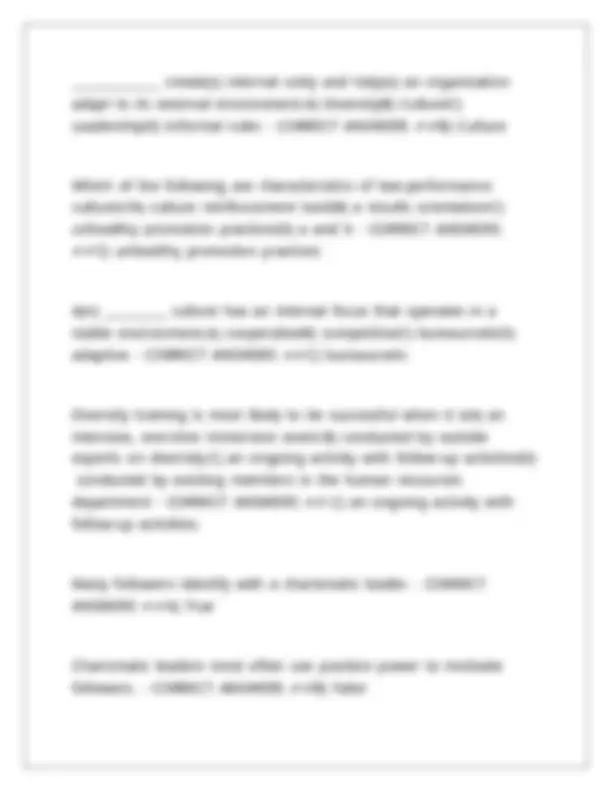
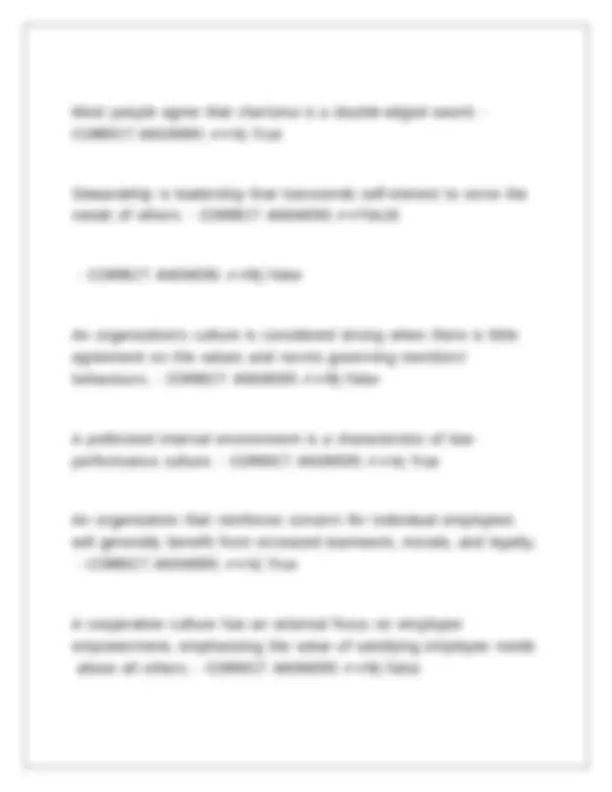
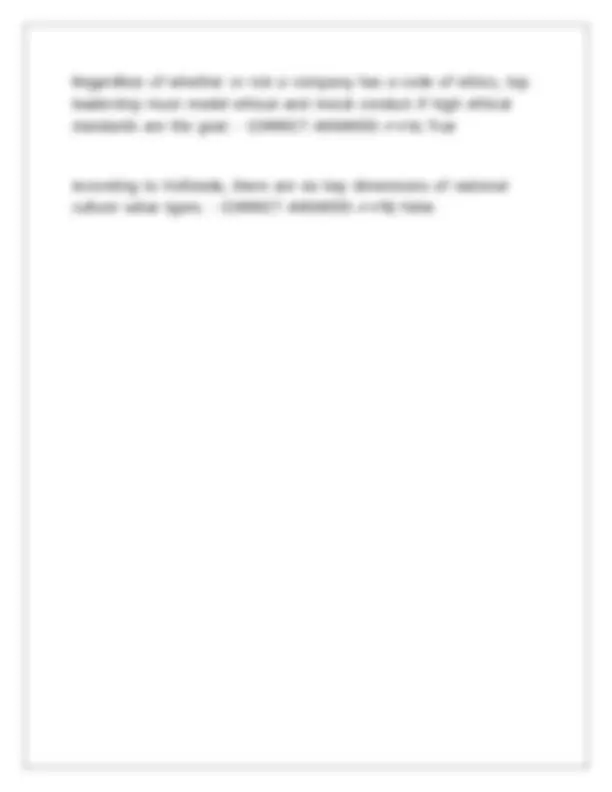


Study with the several resources on Docsity

Earn points by helping other students or get them with a premium plan


Prepare for your exams
Study with the several resources on Docsity

Earn points to download
Earn points by helping other students or get them with a premium plan
Community
Ask the community for help and clear up your study doubts
Discover the best universities in your country according to Docsity users
Free resources
Download our free guides on studying techniques, anxiety management strategies, and thesis advice from Docsity tutors
ORGB 327 exam questions with correct answers
Typology: Exams
1 / 53

This page cannot be seen from the preview
Don't miss anything!














































Define |\Leadership |\using |\ 5 |\key |\elements |- |\CORRECT |\ANSWERS |
✔✔Leadership |\is |\the |\influencing |\process |\between |\leaders |\and |
followers |\to |\achieve |\organizational |\objectives |\through |\change. |\Five |
Key |\Elements |(POLICE) |
-People -Organizational |\Obj. -Leaders-followers -Influence -Change Identify |\ 10 |\managerial |\roles |\of |\leaders |\according |\to |\Henry |
Mintzberg |- |\CORRECT |\ANSWERS |\✔✔Interpersonal |\Roles- |\Leader, |
figurehead, |\liaison Informational |\Roles-Monitor, |\Disseminator, |\Spokesperson Decisional |\Roles-Entrepreneur, |\Disturbance |\handler, |\resource |
allocator, |\negotiator 3 |\levels |\at |\which |\the |\concept |\of |\leadership |\may |\be |\analyzed |\and |
studied |- |\CORRECT |\ANSWERS |\✔✔Group, |\Individual |, |\Organizational
Describe |\the |\Four |\Leadership |\Theory |\paradigms |- |\CORRECT |
ANSWERS |\✔✔Trait |\Theory |\Paradigm- |\Explain |\distinctive |
characteristics |\accounting |\for |\leadership |\effectiveness. Behavioral |\Paradigm- |\Explain |\distinct |\styles |\used |\by |\effective |
leaders. Contingency |\Paradigm- |\Explain |\appropriate |\style |\based |\on |\the |
leader, |\followers, |\and |\the |\situation. |
Integrative |\Paradigm- |\Attempt |\to |\combine |\trait, |\behavioral, |
contingency |\theories |\to |\explain |\successful |\influencing |\of |\leaders/followers. List |\Traits |\in |\the |\BIG |\FIVE |\model |\of |\Personality |- |\CORRECT |
ANSWERS |\✔✔Surgency- |\Dominance, |\Extroversion, |\Energy/determination |
Agreeableness- |\Sociability, |\EI Adjustment-Emotional |\Stability/Narcissist's, |\Self-confidence Conscientiousness- |\Dependability, |\Integrity Openness- |\Flexibility, |\Intelligence, |\Locus |\of |\control Traits |\of |\effective |\Leaders |\are? |- |\CORRECT |\ANSWERS |
✔✔Achievement |\motivation, |\Leader |\motive describe |\the |\Achievement |\Motivation |\Theory |\and |\the |\Leader |\Motive |\Profile |\Theory. |- |\CORRECT |\ANSWERS |\✔✔Achievement |\Motivation |\
Avoid |\negative |\people Set |\and |\achieve |\goals Focus |\on |\your |\success |\not |\failure Don't |\compare |\yourself |\to |\others Accept |\compliments Be |\a |\positive |\role |\model identify |\factors |\that |\influence |\ethical |\behavior. |- |\CORRECT |\ANSWERS |\✔✔Incentives Personality |\traits |\or |\attitudes Moral |\development Situations Integration discuss |\the |\various |\ways |\by |\which |\people |\justify |\unethical |\behavior, |- |\CORRECT |\ANSWERS |\✔✔Higher |\purpose Displacement |\of |\responsibility Diffusion |\of |\responsibility Advantageous |\comparison Disregard |\of |\consequence Attribution |\of |\blame Euphemistic |\labelling
What |\is |\University |\of |\Iowa |\Leadership |\model |- |\CORRECT |\ANSWERS |
✔✔They |\identify |\two |\basic |\leadership |\styles Autocratic |\leadership |- |\makes |\the |\decisions |, |\tells |\employees |\what |
to |\do |\and |\closely |\supervises Democratic |\leadership |\style- |\encourages |\participation |\in |\decisions, |
works |\with |\employees |\to |\determine |\what |\to |\do |\and |\does |\not |
closely |\supervise |\employees University |\of |\Michigan |\Leadership |\Model |- |\CORRECT |\ANSWERS |
✔✔Job |\centered |\Leadership |\OR |\Employee |\centered |\leadership Ohio |\State |\University |\Model |- |\CORRECT |\ANSWERS |\✔✔Two |
Dimensional |- |\Consideration |\of |\employees, |\Structure |\of |\job •Initiating |\structure |\behavior. |\The |\initiating |\structure |\leadership |\style |\is |\essentially |\the |\same |\as |\the |\job-centered |\leadership |\style; |\it |
focuses |\on |\getting |\the |\task |\done. •Consideration |\behavior. |\The |\consideration |\leadership |\style |\is |
essentially |\the |\same |\as |\the |\employee-centered |\leadership |\style; |\it |
focuses |\on |\meeting |\peoples |\needs |\and |\developing |\relationships. |
(Lussier, |\20150101, |\p. |\74)
describe |\the |\contingency |\leadership |\theory. |- |\CORRECT |\ANSWERS |
✔✔Both |\the |\trait |\and |\behavioural |\leadership |\theories |\were |
attempts |\to |\find |\the |\one |\best |\leadership |\style |\in |\all |\situations. |
Contingency |\is |\based |\on |\behavioural |\leadership |\but |\leaders |\need |\to |\change |\their |\behaviour |\to |\meet |\the |\situational |\characteristics Contingency |\Leadership |\Theory- |- |\CORRECT |\ANSWERS |\✔✔Used |\to |
determine |\if |\a |\persons |\leadership |\style |\is |\task |\or |\relationship |
orientated, |\and |\if |\the |\situation |\matches |\the |\leadership |\style |\to |
maximize |\performance Leadership |\continuum |\theory |- |\CORRECT |\ANSWERS |\✔✔leadership |
behavior |\is |\on |\a |\continuum |\from |\boss-centered |\to |\subordinate |
centered |\leadership. Path- |\Goal |\Leadership |\Theory |- |\CORRECT |\ANSWERS |\✔✔used |\to |
select |\leadership |\style |\to |\maximize |\both |\performance |\and |\job |
satisfaction Normative |\Leadership |\Theory |- |\CORRECT |\ANSWERS |\✔✔time-driven |
and |\development-driven |\decision |\enables |\user |\to |\select |\one |\of |\the |
five |\styles |\for |\appropriate |\decision. What |\are |\differences |\between |\Behavioral/Contingency |\Theories |- |
CORRECT |\ANSWERS |\✔✔Behavioural |\Theories
Michigan-Job |\Centered, |\Employee |\Centered Ohio |\State |- |\High,High,Low,Low, |\Structure/Consideration Contingency |\Theories Contingency |\Model-Task,Relationship Path-Goal |\Model-Directive,achievement,supportive,participative Normative |\Leadership |\Model- Decide,Consult |\individual |\or |\Group, |\Facilitate,Delegate Discuss |\the |\major |\similarities |\and |\differences |\between |\the |
behavioral |\and |\contingency |\leadership |\theories |- |\CORRECT |
ANSWERS |\✔✔.The |\primary |\similarity |\between |\these |\theories |\is |\that |
their |\leadership |\styles |\are |\all |\based |\on |\the |\same |\two |\leadership |
concepts, |\although |\they |\have |\different |\names. |\The |\major |\difference |\is |\that |\the |\contingency |\leadership |\models |\identify |\contingency |
variables |\on |\which |\to |\select |\the |\most |\appropriate |\behavioral |
leadership |\style |\for |\a |\given |\situation Power |- |\CORRECT |\ANSWERS |\✔✔Leaders |\potential |\influence |\on |
followers Politics |- |\CORRECT |\ANSWERS |\✔✔Process |\of |\gaining |\and |\using |
power
explain |\the |\steps |\in |\the |\negotiation |\process. |- |\CORRECT |\ANSWERS |
✔✔The |\first |\step |\in |\the |\negotiation |\process |\is |\to |\plan |\for |\the |
negotiation. |\The |\second |\step |\is |\to |\conduct |\the |\actual |\negotiation, |
which |\can |\be |\postponed |\and |\results |\in |\an |\agreement |\or |\no |
agreement. Steps |\in |\message |\sending |\Process |- |\CORRECT |\ANSWERS |\✔✔Develop |\rapport, |\State |\communication |\obj., |\transmit |\message, |\check |
receivers |\understanding, |\give |\a |\commitment |\and |\follow |\up Steps |\in |\message |\receiving |\process |- |\CORRECT |\ANSWERS |
✔✔Listening, |\analyzing, |\checking |\for |\understanding. describe |\the |\four |\recommendations |\for |\encouraging |\feedback |\from |
others. |- |\CORRECT |\ANSWERS |\✔✔Be |\open |\to |\feedback Be |\aware |\of |\nonverbal |\cues Ask |\Questions Use |\paraphrasing list |\and |\describe |\the |\ 10 |\coaching |\guidelines, |\and |\the |\relationship |
between |\the |\performance |\formula |\and |\the |\coaching |\model. |- |
CORRECT |\ANSWERS |\✔✔1.Develop |\a |\supportive |\working |\relationship. 2.Give |\praise |\and |\recognition. 3.Avoid |\blame |\and |\embarrassment.
4.Focus |\on |\the |\behavior, |\not |\the |\person. 5.Have |\employees |\assess |\their |\own |\performance. 6.Give |\specific |\and |\descriptive |\feedback. 7.Give |\coaching |\feedback. 8.Provide |\modeling |\and |\training. 9.Make |\feedback |\timely, |\but |\flexible 10.Don't |\criticize. define |\conflict, |\and |\identify |\the |\five |\conflict |\management |\styles. |- |
CORRECT |\ANSWERS |\✔✔Conflict |\is |\when |\people |\are |\in |\disagreement (1) |\The |\avoiding |\conflict |\style |\user |\attempts |\to |\passively |\ignore |\the |
conflict |\rather |\than |\resolve |\it. (2) |\The |\accommodating |\conflict |\style |\user |\attempts |\to |\resolve |\the |
conflict |\by |\passively |\giving |\in |\to |\the |\other |\party. (3) |\The |\forcing |\conflict |\style |\user |\attempts |\to |\resolve |\the |\conflict |\by |\using |\aggressive |\behavior |\to |\get |\his |\or |\her |\own |\way. (4) |\The |\negotiating |\conflict |\style |\user |\attempts |\to |\resolve |\the |
conflict |\through |\assertive, |\give-and-take |\concessions. (5) |\The |\collaborating |\conflict |\style |\user |\assertively |\attempts |\to |
jointly |\resolve |\the |\conflict |\with |\the |\best |\solution |\agreeable |\to |\all |
parties. |(Lussier, |\20150101, |\p. |\210) discuss |\the |\steps |\in |\the |\initiating |\conflict |\resolution |\model. |- |
CORRECT |\ANSWERS |\✔✔
influencing |\the |\LMX |\relationship. |\Other |\factors |\such |\as |\a |\leader's |
resource |\strength, |\span |\of |\control, |\and |\ability |\to |\create |\a |
supportive |\work |\climate |\or |\environment |\will |\also |\greatly |\influence |
LMX |\relationships.The |\Follower's |\Role. |\Proactive |\followers |\who |\want |
to |\influence |\LMX |\relationships |\with |\their |\leaders |\can |\employ |\tactics |
such |\as |\impressions |\management, |\ingratiation |\and |\self-promotion. explain |\the |\concept |\of |\followership |\and |\outline |\the |\five |\follower |
types |- |\CORRECT |\ANSWERS |\✔✔Followership |\refers |\to |\behavior |\of |
followers |\that |\result |\from |\the |\leader |\follower |\mutual |\influencing |
relationship define |\the |\three |\determinants |\of |\follower |\influence. |- |\CORRECT |
ANSWERS |\✔✔(1) |\Relative |\power |\position—leaders |\need |\to |\realize |
that |\followers |\also |\have |\the |\power |\to |\influence |\them. (2) |\Locus |\of |\control—followers |\can |\have |\an |\internal |\or |\external |
locus |\of |\control, |\based |\on |\their |\belief |\about |\who |\is |\the |\master |\of |
their |\destiny. |\Thus, |\leader-member |\exchanges |\should |\be |\different |
based |\on |\locus |\of |\control. (3) |\Education |\and |\experience—leaders |\need |\to |\realize |\that |\followers |\may |\have |\different |\levels |\of |\education |\and |\experience |\and |\that |
they |\need |\to |\supervise |\them |\differently discuss |\the |\benefits |\of |\delegation, |\and |\list |\the |\things |\leaders |
should |\and |\should |\not |\delegate. |- |\CORRECT |\ANSWERS |\✔✔A |\leader |\
should |\delegate |\paperwork, |\routine |\tasks, |\technical |\matters, |\tasks |
with |\developmental |\potential, |\and |\employees' |\own |\problems describe |\the |\steps |\in |\the |\delegation |\model. |- |\CORRECT |\ANSWERS |
✔✔(1) |\explain |\the |\need |\for |\delegating |\and |\the |\reasons |\for |\selecting |\the |\employee; (2) |\set |\objectives |\that |\define |\responsibility, |\level |\of |\authority, |\and |
deadline; (3) |\develop |\a |\plan; |\and (4) |\establish |\control |\checkpoints |\and |\hold |\employees |\accountable. differentiate |\between |\groups |\and |\teams, |\and |\discuss |\the |
advantages |\and |\disadvantages |\of |\team-based |\work. |- |\CORRECT |
ANSWERS |\✔✔Group- |\Collection |\of |\individuals |\who |\interact |\primarily |
to |\share |\information |\and |\to |\make |\decisions |\that |\enable |\each |
member |\to |\perform |\within |\his |\area |\of |\responsibility. Team |\creates |\synergy, |\Unit |\of |\interdependent |\individuals |\with |
complemntary |\skills |\who |\are |\committed |\to |\a |\common |\purpose |\and |
set |\of |\performance |\outcomes |\and |\to |\common |\expectations, |\for |
which |\they |\hold |\themselves |\accountable. Groups |\focus |\on |\individual |\tasks, |\teams |\have |\a |\collective |\mentality |
that |\focuses |\on |\the |\following:
social |\exchanges |\with |\peers |\in |\terms |\of |\the |\mutual |\exchange |\of |
ideas, |\support, |\and |\feedback. Team |\Effectiveness- Task |\performance |-Degree |\to |\which |\the |\teams |\output |\meets |\the |
needs |\and |\expectations |\of |\those |\who |\use |\it Group |\process- |\Degree |\to |\which |\members |\interact |\or |\relate |\in |\ways |\that |\allow |\the |\team |\to |\work |\increasingly |\well |\together. Individual |\satisfaction- |\Degree |\to |\which |\the |\group |\experience |\on |
balance |\is |\more |\satisfying |\then |\frustrating |\to |\individuals describe |\how |\team |\leadership |\contributes |\to |\team |\effectiveness. |- |
CORRECT |\ANSWERS |\✔✔•The |\team |\leader |\as |\chief |\motivator. •The |\team |\leader |\as |\coach |\and |\mentor •The |\team |\leader |\as |\a |\role |\model. |
•The |\team |\leader |\as |\team |\culture |\enforcer. |
•The |\team |\leader |\as |\cheerleader. •The |\team |\leader |\as |\resource |\person. explain |\how |\organizational |\culture |\influences |\team |\creativity. |- |
CORRECT |\ANSWERS |\✔✔Org. |\culture |\that |\supports |\and |\encourages |
creativity |\provides |\protection |\that |\team |\members |\need |\to |\take |
creative |\risks. |\Diverse |\teams |\enhances |\creativity. |\Create |\a |\culture |
that |\breeds |\creativity.
Organizations |\that |\have |\a |\culture |\that |\supports |\and |\promotes |\team |\creativity |\have |\a |\team-goal |\orientation, |\team-centered |\recognition |
and |\rewards |\programs, |\team-centered |\resource |\allocation |\policies, |
flexible |\operating |\procedures, |\team |\diversity, |\and |\a |\team-centered |
leadership |\development |\program describe |\the |\following |\kinds |\of |\teams: |\functional, |\cross-functional, |
virtual, |\and |\self-managed. |- |\CORRECT |\ANSWERS |\✔✔Functional |\team- |\group |\of |\employees |\belonging |\to |\the |\same |\functional |\department |
who |\have |\common |\obj. Cross |\functional |- |\Composed |\of |\memebers |\from |\diffferent |
departments |\who |\are |\brought |\together |\to |\perform |\unique |\tasks |\to |
create |\new |\and |\non |\routine |\products |\and |\services Virtual |\team- |\Memebrs |\geographicallly |\dispersed |, |\requiring |\them |
to |\work |\together Self |\managed |\team- |\members |\share |\or |\rotate |\leadership |
responsibilityies |\hole |\one |\another |\accountable. explain |\how |\organizational |\climate |\and |\top |\management |\can |
contribute |\to |\team |\creativity. |- |\CORRECT |\ANSWERS |\✔✔Organizations |\that |\have |\a |\culture |\that |\supports |\and |\promotes |\team |\creativity |
have |\a |\team-goal |\orientation, |\team-centered |\recognition |\and |
rewards |\programs, |\team-centered |\resource |\allocation |\policies, |\
ANSWERS |\✔✔ 1 |) |\identify |\objectives |\2) |\covering |\agenda |\items |\3) |
summarizing |\and |\reviewing |\assignments describe |\what |\self-managed |\teams |(SMTs) |\are |\and |\discuss |\their |
benefits. |- |\CORRECT |\ANSWERS |\✔✔Benefits- |\increased |\productivity, |
new |\product |\development |\and |\process |\improvements, |\greater |
product/service |\quality, |\improved |\worker |\participation, |\better |
decisions |\overall. |\Because |\its |\collective |\decision |\members |\commit |
more. Describe |\the |\benefits |\of |\using |\self-managed |\teams |\in |\organizations. SMTs (I) |\create |\a |\stronger |\sense |\of |\commitment |\to |\the |\work |\effort |
among |\team |\members; (2) |\improve |\quality, |\speed, |\and |\innovation; (3) |\have |\more |\satisfied |\employees |\and |\lower |\turnover |\and |
absenteeism; (4) |\facilitate |\faster |\new-product |\development; (5) |\allow |\cross-trained |\team |\members |\greater |\flexibility |\in |\dealing |
with |\personnel |\shortages |\due |\to |\illness |\or |\turnover; |\and (6) |\keep |\operational |\costs |\down |\because |\of |\reductions |\in |
managerial |\ranks |\and |\increased |\efficiencies. Challenges |\of |\SMT |- |\CORRECT |\ANSWERS |\✔✔Many |\of |\the |\challenges |\of |\implementing |\SMTs |\stem |\from |\the |\difficulties |\of |\transitioning |
from |\a |\traditional |\command-and-control |\work |\environment |\to |\SMTs.
|\Managers |\who |\have |\become |\accustomed |\to |\traditional, |\autocratic |
management |\and |\jaded |\by |\management |\fads |\that |\come |\and |\go |
may |\resist |\or |\undermine |\a |\team |\approach. |\Even |\among |\members |
of |\the |\non-managerial |\ranks, |\the |\transition |\to |\SMTs |\has |\as |\much |
potential |\for |\frustrations |\and |\problems |\as |\it |\does |\for |\managers. |
This |\is |\usually |\due |\to |\unfamiliarity |\with |\the |\new |\structure |\and |\new |
routines |\and |\adjusting |\to |\team |\responsibilities. |\The |\greatest |
challenge |\may |\lie |\in |\setting |\and |\enforcing |\new |\behavioral |
expectations, |\made |\necessary |\by |\the |\absence |\of |\a |\traditional |\leader |\and |\the |\presence |\of |\new |\employee |\rights |\and |\responsibilities What |\is |\SMT |\facilitator |- |\CORRECT |\ANSWERS |\✔✔SMT |\facilitator |\is |
the |\external |\leader |\of |\an |\SMT, |\whose |\job |\is |\to |\create |\optimal |
working |\conditions |\so |\that |\team |\members |\take |\on |\responsibilities |
to |\work |\productively |\and |\solve |\complex |\problems |\on |\their |\own explain |\Max |\Weber's |\view |\of |\charisma. |- |\CORRECT |\ANSWERS |
✔✔Charisma |\is |\not |\something |\found |\soleley |\in |\the |\leader |\as |\a |
phsycological |\phenomenone |\nor |\is |\it |\situationally |\determined. Charisma |\is |\defined |\as |\a |\social |\construct |\between |\the |\leader |\and |
follower, |\in |\which |\the |\leader |\offers |\a |\transformative |\vision |\or |\ideal |
that |\exceeds |\the |\status |\quo |\and |\convinces |\followers |\to |\accept |\this |
course |\of |\action |\because |\of |\belief |\in |\leader |. explain |\what |\is |\meant |\by |\the |\locus |\of |\charismatic |\leadership, |\and |
discuss |\the |\effects |\that |\charismatic |\leaders |\have |\on |\their |\followers. |- |\CORRECT |\ANSWERS |\✔✔What |\is |\the |\basis |\of |\charisma, |\Is |\it |\either